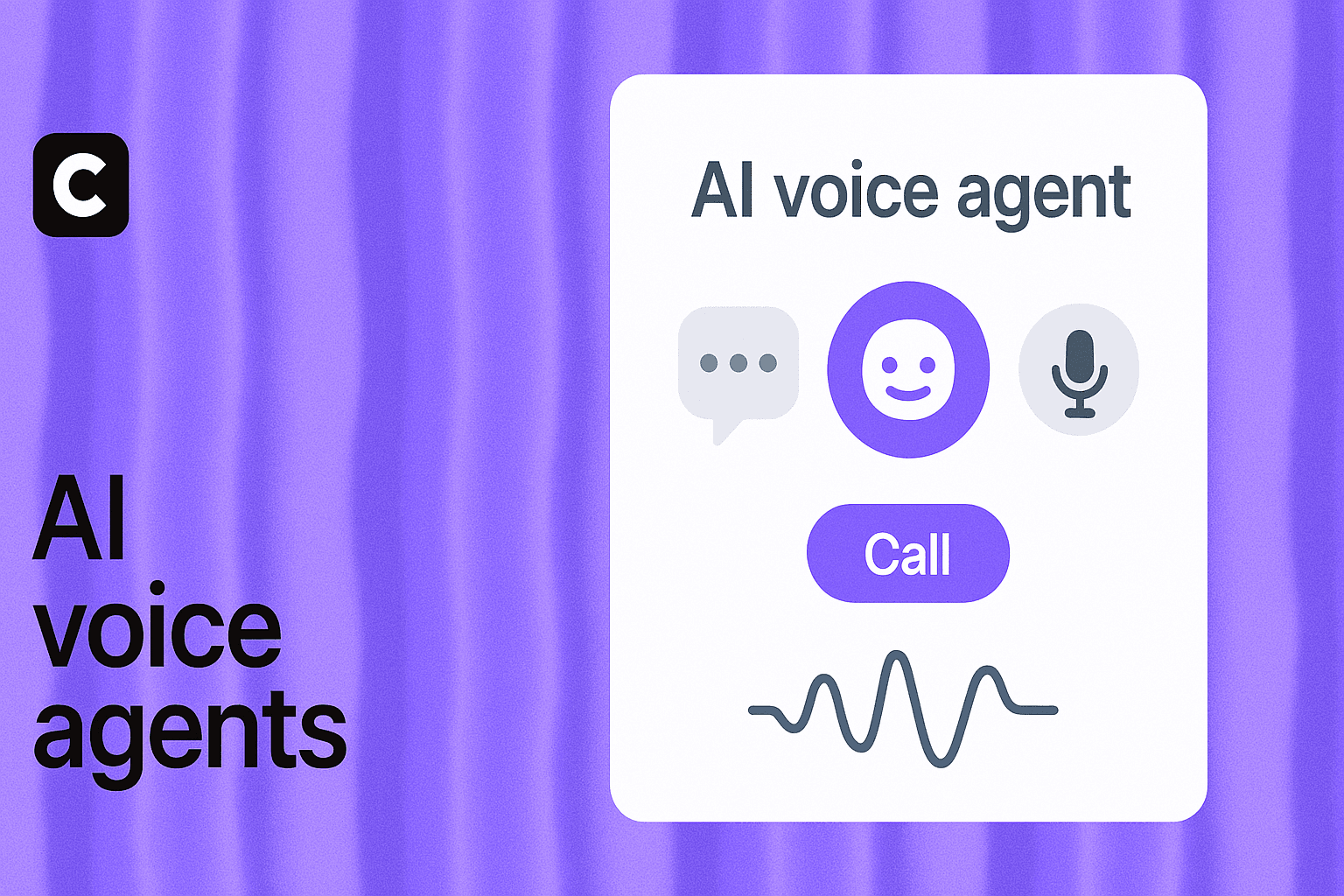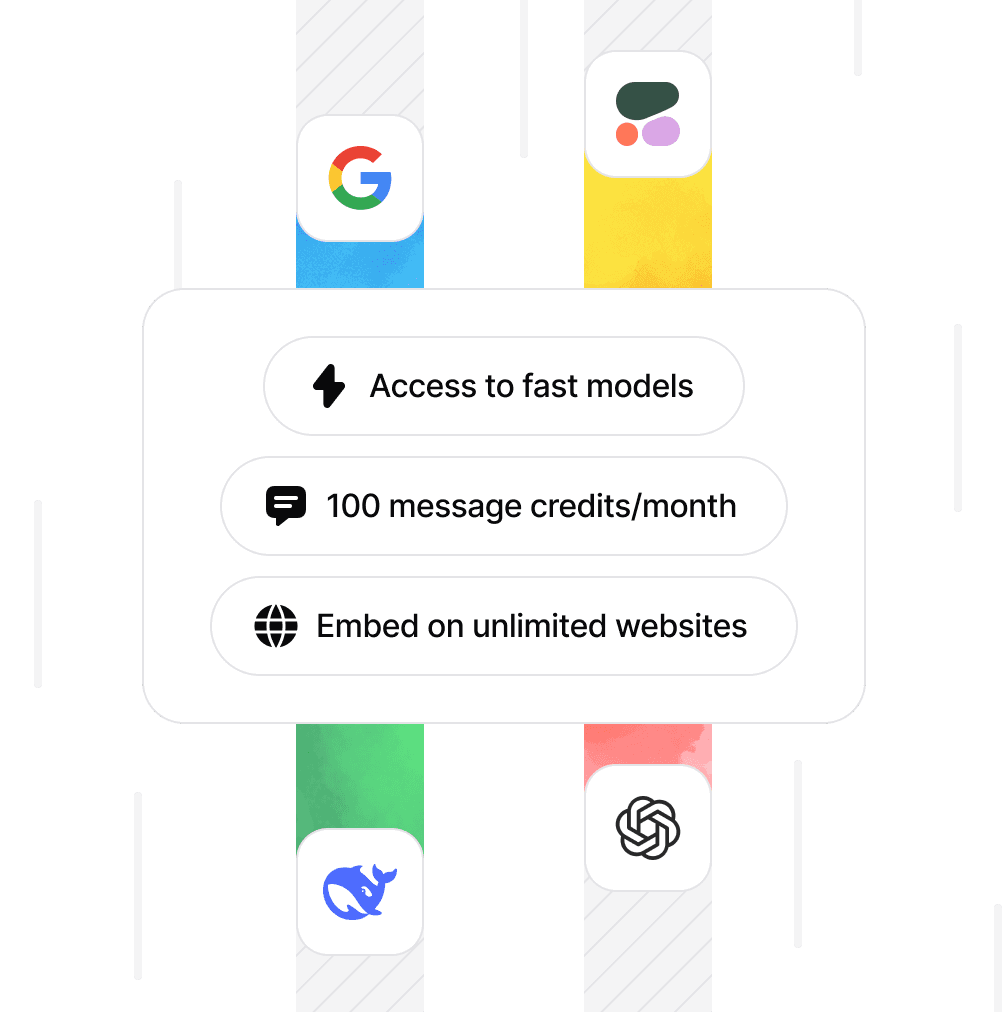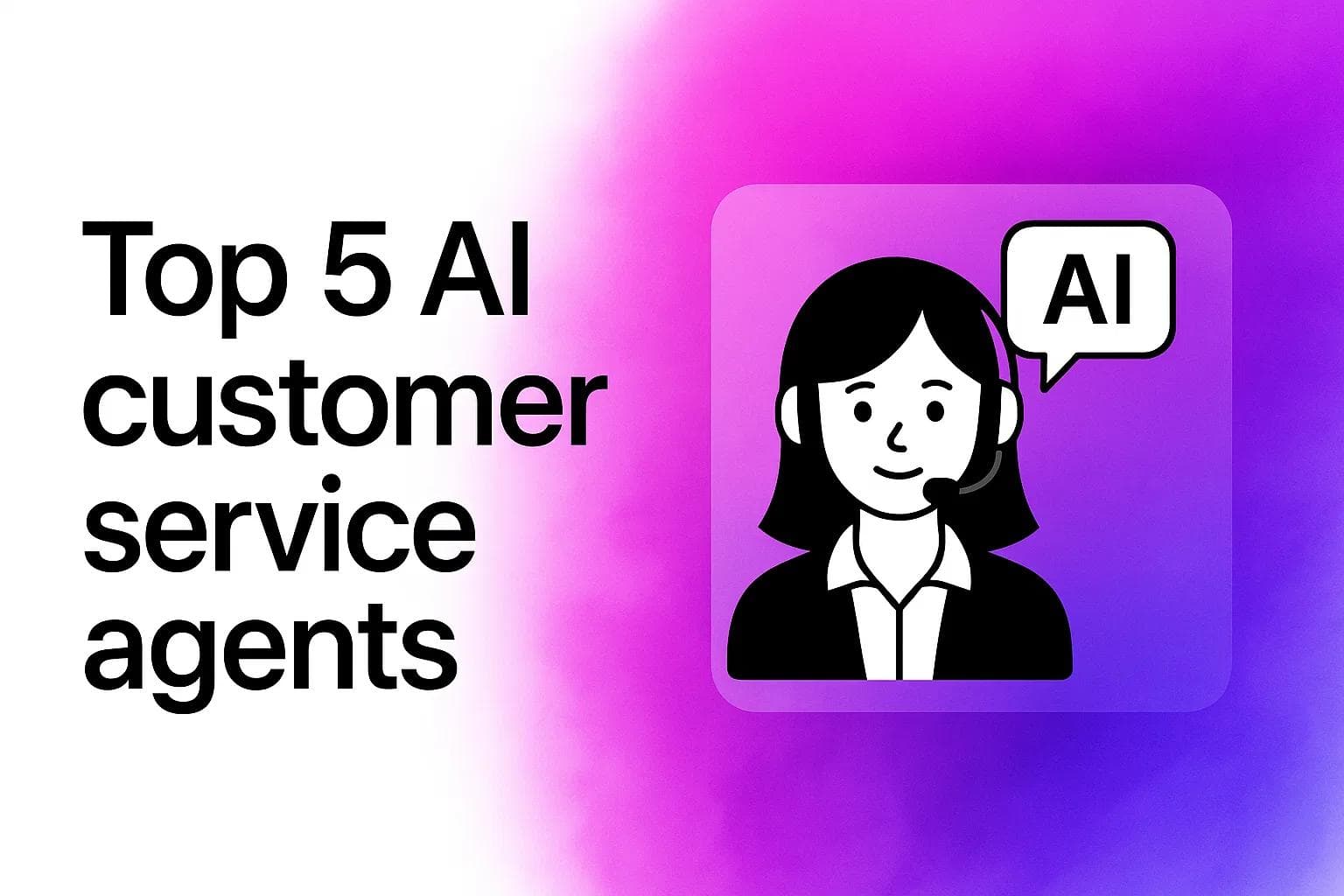What are AI Voice Agents & How to Build One
Ilias Ism
Apr 7, 2025
14 min read

Summary by Chatbase AI
AI Voice Agents are advanced software systems designed to understand, interpret, and respond to human speech in real-time, enabling natural, conversational interactions
AI voice agents are AI-powered systems that understand and respond to human speech, allowing for natural, spoken conversations to complete tasks or provide information.
What is an AI voice agent?
An AI Voice Agent is an intelligent software system that uses artificial intelligence to understand, interpret, and respond to human speech in real-time.
Think of it as a virtual assistant or automated agent that you can talk to naturally, often over the phone or other voice channels. It uses technologies like:
- Speech Recognition (Speech-to-Text): To understand what you said.
- Natural Language Processing (NLP) & Large Language Models (LLMs): To figure out the meaning and intent behind your words.
- Text-to-Speech (TTS): To reply back in a human-like voice.
Unlike simple automated menus (IVRs) or basic virtual assistants (like Siri or Alexa for simple tasks), AI Voice Agents are often designed for more complex, conversational tasks, such as customer service, scheduling appointments, or processing orders, aiming for a more natural and efficient interaction.
Why are AI voice agents important?
Here is why AI Voice Agents are relevant and why you should care about them:
They Are Changing How You Interact with Businesses:
- Better Customer Service (Potentially): Instead of frustrating phone menus ("Press 1...") or long hold times, you might increasingly talk to an AI agent that can understand your problem and potentially solve it instantly, 24/7.
- Faster Information & Tasks: Need to track an order, book an appointment, or get a quick answer? An AI voice agent can often do this much faster than navigating a website or waiting for a human agent for simple requests.
They Improve Accessibility:
- For people with visual impairments or physical disabilities that make typing difficult, voice interaction is a crucial way to access information and services. AI agents make this more powerful and widespread.
This is particularly valuable for individuals navigating complex processes like disability benefits applications, where working with a social security advocate often involves extensive documentation and form completion.
They Are Becoming More Commonplace:
- You're already interacting with simpler forms (Siri, Alexa). More sophisticated versions are being rapidly adopted by banks, airlines, healthcare providers, retailers, and more. Understanding them helps you navigate these interactions better.
They Impact the Job Market:
- While they automate some tasks previously done by humans (like basic customer support), they also create new jobs in AI development, training, conversation design, and maintenance. Understanding this technology is becoming a valuable skill.
They Represent the Future of Interaction:
- Voice is a natural way for humans to communicate. As AI gets better, expect smoother, more integrated voice control and interaction with technology in cars, homes, and workplaces. Knowing about them helps you understand where technology is heading.
In short: You should care because AI Voice Agents directly affect how you get service, access information, and interact with technology, and they are a growing part of the technological landscape that impacts accessibility, jobs, and future innovation.
How do AI voice agents work?
Okay, here's how an AI voice agent typically works, broken down into simple steps:
- You Speak (Input): You say something to the agent, like "What time does the bank close?"
- It Listens (Speech-to-Text / ASR): The system uses Automatic Speech Recognition (ASR) technology to convert your spoken words (audio) into digital text. Think of it as a highly accurate transcriber.
- It Understands (Natural Language Understanding / NLU/LLM): The text is then processed using Natural Language Understanding (NLU), often powered by advanced AI like Large Language Models (LLMs). This part figures out:
- Intent: What you want to do (e.g., find closing time).
- Entities: Key pieces of information (e.g., "bank," "time").
- It Thinks & Finds the Answer (Dialog Management & Backend Integration): Based on your intent, the Dialog Management system decides what to do next. This usually involves:
- Checking its knowledge base or rules.
- Accessing external systems or databases (like querying the bank's actual operating hours stored elsewhere).
- Formulating a response in text form.
- It Speaks Back (Text-to-Speech / TTS): Finally, the system uses Text-to-Speech (TTS) technology to convert its text answer back into natural-sounding spoken audio.
- You Hear the Response: The audio is played back to you (e.g., "The bank closes at 5 PM today.").
Essentially, it's a cycle: Listen -> Understand -> Think/Act -> Respond, all powered by different AI technologies working together very quickly.
5 Ways to Set Up an AI Voice Agent
Okay, setting up an AI voice agent isn't a single click, but rather involves choosing an approach based on your technical skills, budget, customization needs, and the complexity of the agent you want.
Here are the top 5 common ways to set them up, ranging from simpler to more complex:
1. Using No-Code/Low-Code Platforms:
- How it works: These platforms provide visual drag-and-drop interfaces or simple configuration tools to design conversation flows, define intents (what the user wants), and connect to basic functions. You typically don't need to write much, if any, code.
- Examples: Voiceflow, Chatbase (often text-first but can integrate voice), Landbot, some features within platforms like HubSpot or Intercom might lean this way.
- Best for: Simple agents (FAQs, basic lead capture, simple appointment booking), prototypes, non-technical users, or quickly testing ideas.
- Setup involves: Designing the conversation visually, defining user inputs and agent responses, configuring basic settings.
2. Leveraging Cloud AI Platform Services:
- How it works: Major cloud providers offer powerful, managed services specifically for building conversational AI. You configure the components (speech recognition, language understanding, speech synthesis, dialog logic) using their web consoles and APIs. They handle the underlying AI models and infrastructure.
- Examples: Google Cloud Dialogflow (including Agent Builder), Amazon Lex, Microsoft Azure Bot Service & Azure AI Speech.
- Best for: More sophisticated agents needing Enrichment API integrations, database lookups, complex logic, scalability, and benefiting from robust pre-trained models. Requires some technical understanding.
- Setup involves: Defining intents and entities, designing conversation flows (often graphically or via code), configuring API integrations, training the NLU model with examples, selecting voices, deploying endpoints.
3. Configuring Pre-built Agents within Business Software:
- How it works: Many Customer Relationship Management (CRM) or Contact Center as a Service (CCaaS) platforms now include built-in AI agent capabilities specifically tailored for their ecosystem (e.g., customer service). You configure these agents within the platform's settings.
- Examples: Salesforce Einstein Bots (with voice capabilities), NICE CXone, Genesys Cloud CX, Zendesk AI.
- Best for: Businesses already using these platforms who want voice agents tightly integrated with their existing customer data and workflows.
- Setup involves: Enabling the feature, configuring specific workflows and knowledge bases within the platform's admin interface, defining agent tasks relevant to the platform (e.g., checking order status in the CRM).
4. Using Open-Source Frameworks:
- How it works: These provide the core building blocks and libraries, but you need to write code to assemble, train, and deploy the agent. You have full control over the models (often using pre-trained ones as a base), logic, and deployment environment.
- Examples: Rasa, potentially using frameworks like LangChain or LlamaIndex combined with separate STT/TTS libraries.
- Best for: Highly customized agents, complex integrations, specific privacy requirements (can be self-hosted), teams with strong development skills wanting maximum flexibility.
- Setup involves: Writing code (often Python), defining NLU training data, building conversation logic (stories/rules/policies), managing dependencies, setting up hosting infrastructure, training models.
5. Custom Development with Specialized APIs/SDKs:
- How it works: Instead of an all-in-one platform, you pick best-of-breed APIs for each component (Speech-to-Text, NLU/LLM, Text-to-Speech) and write code to integrate them and manage the conversation logic yourself.
- Examples: Combining Twilio for telephony, OpenAI API (Whisper for STT, GPT for NLU/logic, TTS API), ElevenLabs or PlayHT for highly realistic TTS, Deepgram for STT, and writing your own application logic (e.g., in Python or Node.js) to tie it all together.
- Best for: Unique requirements where specific component performance (e.g., ultra-realistic voice, lowest latency STT) is critical, complex custom logic, integrating into existing complex applications. Requires significant development expertise.
- Setup involves: Selecting and integrating multiple APIs, writing substantial custom code for dialog management and backend connections, managing API keys and costs, and understanding the overall AI development cost before deploying the entire application.
The best way for you depends heavily on your project's goals and your available resources and technical expertise. Understanding AI voice agent pricing structures across different platforms helps businesses make informed decisions about which approach aligns with their budget and requirements.
5 tips for getting started with AI voice agents
Okay, here are 5 key tips for successfully implementing an AI voice agent:
1. Start with Clear Goals and a Defined Scope
- Why: Don't try to build an agent that does everything at once. Clearly define exactly what problem you want the voice agent to solve or what specific task(s) it should handle (e.g., answer FAQs about store hours, book simple appointments, track order status).
- How: Identify a high-volume, repetitive, or simple task first. Define clear Key Performance Indicators (KPIs) to measure success (e.g., call deflection rate, task completion rate, customer satisfaction score). This prevents scope creep and ensures you're solving a real need.
2. Focus Heavily on Conversation Design (User Experience)
- Why: A voice agent that's confusing, unnatural, or frustrating to talk to will fail, no matter how powerful the underlying AI is. The flow of the conversation is critical.
- How: Map out realistic conversation paths. Use natural language. Design how the agent should handle errors, ambiguity ("I didn't understand that"), and asking for clarification. Set user expectations clearly at the beginning of the interaction about what the agent can do. Test designs with real users if possible.
3. Plan for Backend Integration Early
- Why: Most useful voice agents need to connect to other systems (databases, APIs, CRMs, booking platforms) to fetch information or perform actions. This integration is often the most complex part.
- How: Identify exactly what data the agent needs access to and what actions it needs to trigger in other systems. Understand the APIs or integration points available. Factor the complexity and potential challenges of this integration into your project timeline and resource planning from the start.
4. Implement in Phases and Iterate
- Why: Launching a complex agent all at once is risky. A phased approach allows you to test, learn, and improve based on real-world interactions before a full rollout.
- How: Start with a pilot program or a Minimum Viable Product (MVP) focusing on the core functionality defined in Tip 1. Gather data and feedback from this initial phase. Use these insights to fix issues, refine the conversation flow, improve the AI's understanding (retraining), and gradually add more capabilities.
5. Monitor Performance and Continuously Optimize
- Why: An AI voice agent is not a "set it and forget it" solution. User needs change, language evolves, and the agent's performance needs ongoing attention to remain effective.
- How: Regularly review interaction logs, monitor your KPIs (from Tip 1), identify where conversations fail or users get stuck, and collect user feedback. Use this data to retrain the NLU model, update conversation flows, improve responses, and adapt the agent to changing requirements or newly identified user needs.
Conclusion
In conclusion, AI voice agents represent a significant evolution in human-computer interaction, moving beyond simple commands to enable natural, spoken conversations for complex tasks. Powered by core technologies like Automatic Speech Recognition (ASR), Natural Language Understanding (NLU), and Text-to-Speech (TTS), these agents can understand intent, manage dialogue context, and respond intelligently.
Their primary applications lie in automating and enhancing interactions, particularly in customer service, scheduling, and information retrieval, leading to benefits like increased efficiency, 24/7 availability, and potentially improved customer experiences. However, successful implementation isn't guaranteed; it requires clear strategic goals, meticulous conversation design focused on user experience, careful integration with backend systems, and a commitment to ongoing monitoring and iterative improvement based on real-world performance.
As the underlying AI continues to advance, particularly with Large Language Models, voice agents will become even more capable, natural, and integrated into our daily interactions with businesses and technology, solidifying their role as a key interface of the future. Understanding their capabilities and implementation nuances is increasingly crucial for both users and developers.
Share this article:







